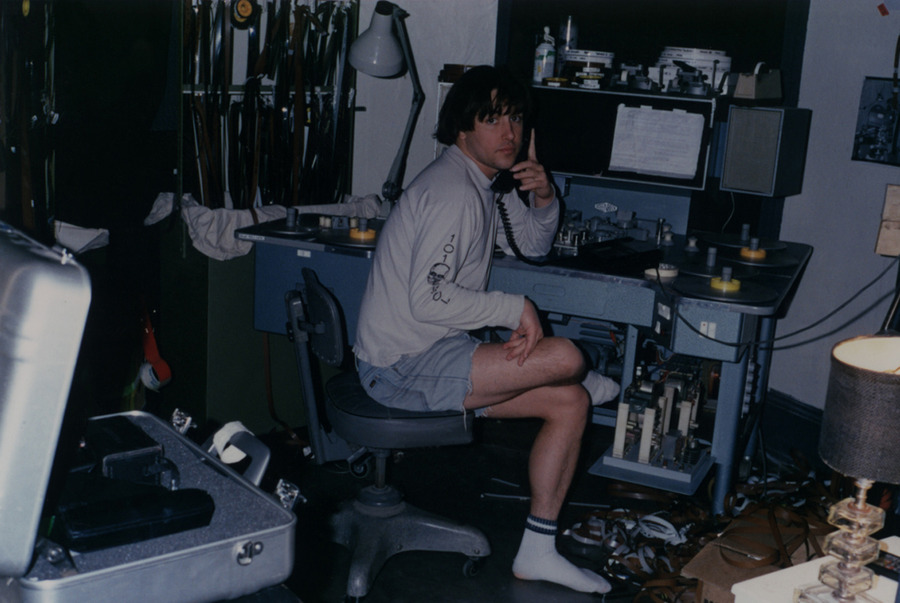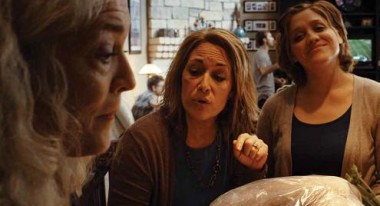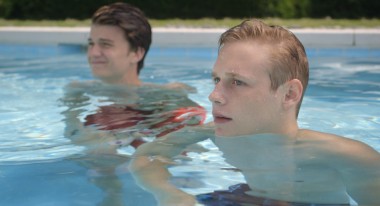 Back to selection
Back to selection
Chronicle of a Dream Foretold: BAMcinemaFest 2015
 Richard Linkater, forefather
Richard Linkater, forefather “Withdrawing in disgust is not the same as apathy,” comments one of the tenuously overlapping characters in Richard Linklater’s 1991 game-changer Slacker. The word itself, fairly recent at the time of production, is a moniker the speaker fully embraces. The branding may sound tactless, if not downright pejorative, but it’s not at all: It implies enough empathy and humanity to seek out options to offset destructive disinterest in matters tangible, ethical, or both.
In the creative sphere, the shift in course can lead to an untried M.O. and the models it might generate — if the stars are properly aligned, that is. Slackerdom is a form of purgatory, the prison limbo before reaching artistic heaven or hell. Linklater himself has spoken of daydreaming, of idleness itself, as pluses on the path toward expressive self-actualization.
An outdoor freebie at Pier One in Brooklyn Bridge Park (one of four features in an archival sidebar), Slacker unintentionally serves as an ideal indie golden-oldie backdrop for the seventh edition of the deservedly lauded BAMcinemaFest (June 17-28). The main strand is comprised of 23 fine new American independent narrative and documentary features and a program of shorts (New York premieres all) culled from direct submissions and such festivals as Sundance, SXSW, True/False, Hot Docs, Toronto, and Berlin.
This direct offshoot of the three-year exhibition Sundance at BAM — which ran beginning in 2006 and was, of course, limited to films that had screened in Park City — was first formulated by former BAM curator Florence Almozini. She successfully tackled the one subject oddly lacking and most needed in the overcrowded New York film-festival scene: American indies. The current three-person programming team of Nellie Killian and David Reilly, who worked with Almozini, and acquisitions/publicity vet Ryan Werner have maintained the exemplary cherry-picking, their eyes, ears, and knack for networking paying even higher dividends than they did in last year’s impressive festival. Dare I say it? This is an event even for those who don’t regard Amerindie movies kindly.

The moviemakers are, according to our definition, slackers to varying degrees. They defy classical norms, whether it be in production or post-production, the relationship between sound and image or manner of characterization or layout of plotlines, or the overall apparatus itself. We might see Linklater as one of several Ground Zeroes whose philosophy of filmmaking helped pave the way for this contemporary crop of directors to hone their craft and apply it by unconventional means to original, challenging, and sometimes subversive manifestations of their daydreams, most demanding an active response. The films are protests manifest not necessarily by what we see on the screen but by less obvious, less overt qualities: the technology deployed, all-around duration, structural foundation, and adherence to the usual rules of continuity editing, just for starters.
Simultaneously, they share common concerns, a reflection of the zeitgeist, no matter how different the modes of production and their forms: sexual conflict, mental equilibrium, jealousy, and friendship between duos are just a few of the topics addressed. Several selections feature artists as principals; others shine their light on more marginalized outsiders. Some explore the dynamics at work within families, whether traditional or reconfigured. I’m not sure if the strain of humor that runs through most of them is inherent in the American-ness of the projects, or in the era from which they emerge. Like many of the Hollywood melodramas of the ‘50s and ‘60s, they can often be read in more than one way, like with tears or chuckles, depending in part on the spectator-subject connect or disconnect at a particular moment.
I do not elaborate on a few new films that I highly recommend: Alex Ross Perry’s feature Queen of Earth and three documentaries, Robert Gordon and Morgan Neville’s Best of Enemies; Frida Barkfors and Lasse Barkfors’s Pervert Park; and Amy Berg’s Prophet’s Prey. The following, however, are the absolute must-sees, reviewed to death without spoilers in order of preference.
- THE RUSSIAN WOODPECKER (Chad Gracia)

“Fedor is so tragic,” the mother of Ukrainian avant-garde artist Fedor Alexandrovich tells the American-born, Russian-speaking filmmaker Chad Gracia in this wildly circuitous doc. She is speaking of the boy who was exposed to radiation from the 1986 nuclear meltdown at Chernobyl at the age of four and became part of the children’s diaspora. He landed in an orphanage, but tragedy has served him well, at least in the creative arena. Life for him is a near-continuous performance piece. In the pieces he develops at the Theater Design Workshop of the National Art Theater in Kiev, he fuses the melancholy of the serious with a natural sense of the absurd, a viable worldview in many Slavic regions.
Here he adds his investigative cap. Intelligent and persistent, and possessed with an encyclopedic memory and rapid brain access to details, Alexandrovich is convinced that the Chernobyl explosion was no accident, that it was a cover-up engineered by a powerful Moscow bureaucrat to hide the failure of a massive, extremely expensive (7 billion rubles) low-frequency transmitter called the Duga. It became known as the Russian Woodpecker because of the pecking sounds its signals made. The motivation behind it was the movement of U.S. forces closer and closer to the Soviet border. The flawed theory was that the emissions could affect the thinking of those at whom it was aimed, although it met an early Waterloo trying to reach North America across the impenetrable Arctic. (The Dew Line is a remnant of Cold War paranoia in the U.S.)
Courageous DP Artem Ryzhykov at his side, Alexandrov interviews a number of ex-Soviet bureaucrats and scientists to prop up his hypothesis. The reactor was intentionally pushed way past its capabilities to cover the ass of the single higher-up who would end up taking the fall. Exhibitionist that he is, Alexandrov occasionally dons a clear plastic jumpsuit over his small naked frame, holding a long pole of light while he surveys a wasteland, exemplified by primary schools reduced to rubble and littered with ineffective gas masks.
The endless twists and turns give the film the feel of a satire of the inner workings of state security and the cabal of the powerful in the USSR. (Alexandrov maintains that Chernobyl marked the end of the Soviet nation.) At the same time, the two collaborators embark on their own non-linear production journey. At one point, Alexandrov drops the project and flees the country, fearful for his young son’s life after phone calls from a security bureau not unlike the one that operated while the USSR was still holding ground.
Ryzhykov not only calls him a traitor, he secretly films him — just as he had done to some of the retired Soviet movers and shakers. What reverses the director’s position yet again, and updates the sordid history that the two men have excavated, is the huge Maidan rebellion in Kiev. It was a magnet for Ukrainians of all stripes and positions to reclaim their native land and its long history of suffering. The unwavering Ryzhykov was badly wounded, although he survived, but the large stage where he publicly announced the findings that had made him so fearful provided Alexandrov a forum to proudly reclaim his patriotism as well as his original goal of divulging truth at any cost.
- KRISHA (Trey Edward Shults)

One of two high points in director Shults’s richly layered observation of troubled sixtysomething prodigal Krisha Fairchild’s frustrating chance (per her sister Robyn, played by Shults’s own mother, Robyn Fairchild) to reconnect on Thanksgiving Day with the extended family she left years before in Texas (she’s an abandoneer, per her bellicose brother-in-law) is the jazzed-up soundtrack recording of Nina Simone’s “Just in Time.” Not just for the piano- and string-heavy music itself, but for its position as a significant bookmark in the storyline.
The song begins in the privacy of an upstairs bathroom in her sister’s charmless two-story exurban Houston McMansion at the moment the recovering alcoholic, carefully made up and attired for the big holiday meal in a Jezebel-esque red dress, clumsily opens a full bottle of red wine, raises it to her lips, and chugs the entire content without the slightest pause.
Certainly no match for the soulful, socially committed Simone, Krisha herself takes on the mantle of performer — a role we had observed her play earlier when this slightly unhinged woman, mumbling to herself, was walking in circles around the open kitchen. She was recuperating from the agonizing strain of presenting a reformed persona to her cynical, straight-arrow suburban relatives. Now, the disinhibiting effects of alcohol have undercut the false façade. She nearly floats at a slow, regal pace down a claustrophobic hallway in which old hanging family photos torment her, climbs down a spiral staircase, and makes what she considers a grand entry into the spacious entertainment area.
Before the incident, in between forced, socially acceptable pleasantries, she had acted the opposite role, the part of spectator. She was an audience of one taking in faces and the memories attached. A double shock terminates that vantage point: She observes her elderly wheelchair-bound mother (Shults’s grandmother, Billie) dissing her to the other relatives; and she watches her estranged son, Trey (the filmmaker himself) — who disowns her the same way she evidently did him in an earlier time of recklessness — being coddled by his uncle, a surrogate father-figure. She ascends the stairs right up to where her she has hidden her safety net, along with some snortable meds. Upon completing the mission, she goes back down to the others, reverting back to observer. She stares at her kinfolk, who interact in slo-mo with one another— but not her. She is the fly on the wall.
High point number two: Just when Simone peaks and the music crescendos with the lyrics “no more doubt, no more fear,” the increasingly unsteady Krisha (yes, played by Shults’s aunt, Krisha Fairchild) is compelled to remove from the oven the huge turkey she had insisted on baking. “Just in Time” has just ended. In a brilliant montage, still in slo-mo, Shults holds the camera on the bird while it slides down the tray, its juices hitting the floor magnified drop by magnified drop, followed by the entrée that was meant to feed about 15 hungry Fairchilds. This is no ordinary fowl, and not on account of its enormity: It is the shared sacrificial beast of reconciliation, perhaps self-absorbed Krisha’s final opportunity to make amends for all of the hurt and pain she has caused over the years.
Naturally, there are ensuing venal altercations and loving confrontations, filmed mostly in close-up. The alternation between accelerated and slowed-down shooting (a shift from very long takes to jump cuts is but one example) is not only an echo of Krisha’s bipolar nature when seamlessly shifting from overdone sweetness to a more credible belligerence, but the formal foundation of the film’s unusual, masterful rhythm. (The dialectic between wide open and constricting spaces adds to its off-and-on-again propulsive feel.) It is musical. The adventurous Shults does not follow conventions of continuity. Simultaneous actions do not need to be cross-cut: They often appear sequentially, one after the other. He has revived the methods of early film pioneers like Edwin S. Porter.
The deft direction — it’s hard to believe this is his first film — is fully supported by Drew Daniels’s cinematography, as well as Brian McOmber’s eerie score and Tim Rakoczy’s haunting sound design. Ultimately, however, the film is owned by Krisha Fairchild, a professional actress whose main claim-to-fame until now has mostly been voiceovers for commercials. It’s difficult to determine how much of the story is drawn from actual people and experiences—I doubt if it’s purely fictionalized psychological horror — but Krisha opens up further the possibilities of family as both source and screen material.
- HENRY GAMBLE’S BIRTHDAY PARTY (Stephen Cone)

A nearly lily-white poolside birthday party in the upper-middle-class Chicago backyard of exuberant, righteous minister “Pastor Bob” Campbell (Pat Healy) and his gorgeous, younger, joyless wife Kat (Elizabeth Laidlaw) celebrates the seventeenth birthday of their handsome, blond-haired, blue-eyed son Henry — the nice, polite, and well-liked boy parents are proud to call their own.
Like many youths his age, he is plagued by his emerging sexuality, which is man-for-man but fairly well masked. Unlike many youths his age, he is a devout, unquestioning Christian, a believer molded by his father, his adopted beliefs reinforced by a constant regimen of prayer, Christian camp, and a crowd of friends from the church. (His older sister, Autumn, played by Nina Ganet, attends a Christian college that refutes evolution.) The fear and anxiety behind the hopelessness of separating his physical and spiritual selves are graters peeling painfully at his sense of self and his sense of worth.
A single shot mid-film of four teens in bathing suits succinctly sums up its principal concerns and plotlines. Logan (Daniel Kyri), the one friend from the church who we know from the time of his arrival is an outsider (he’s black, and glances among others in the pool tell us he is not one of them), a token (Christian folk are benevolent), and a gay man (he’s passive, effeminate, and wrote the script for a production of Guys and Dolls). He stands watching his crush, Henry, who is in turn looking at his best friend and unrequited straight lover, Gabe (Joe Keery). Gabe’s eyes are firmly set on the most attractive babe’s bikini bottom, onto which a pinned silver cross dangles over her pubis.
These kids may exhibit the trappings of religion, even of the fundamental variety, but they are really like other teens. Henry, for example, can’t get into the hymns his father plays on the outdoor speakers and, using his warm connection to his more permissible mom, convinces him to play electronic music. Gabe is having little luck with the young woman, who has her sights set on Henry. She follows him upstairs to his bedroom and initiates a make-out session. They are living, breathing humans above all, although it appears that he is just playing along. When she asks if he would like to become more involved, Henry delivers, in his gentlemanly manner, the film’s funniest line: “Can I get back to you?” Christian and comic are not mutually exclusive.
Director Cone does not harp on just one or two types of troubling inconsistencies; his intelligent script is more all-encompassing than that. Guest Ricky (Patrick Andrews) has some past mental-health issues that could deem him ineligible to once again counsel at the coming Christian summer camp. Pastor Bob’s rebuff leads to a tragic replay of the past that puts a damper on a party that appears to be happy. But the ambience of contentment and love proves to be a fraud except for a few of the more mindless followers, or maybe just those who loudly chant their 100% acceptance of everything they have been taught in what can be a dangerously hermetic Christian milieu.
In a loving conversation inside a car parked out front, Kat confides in Autumn (who has just had a devastating quarrel with her b/f) that she had had an affair with Ricky’s late father (and Pastor Bob’s mentor) because of the sensuality he provided her and the way he gazed at her — things missing in her own marital relationship. No one is innocent: Bob and close middle-aged pal Larry (Francis Guinan) are not above sneaking glasses of wine in the utility room.
Larry, a crotchety but decent cynic, is the moral compass of the movie, espousing the values of acceptance and difference, and decrying hypocrisy even while swerving side-to-side from the illicit alcohol. In some truly poignant scenes, the feeling of sacredness tinges the most mundane of actions. A spiritual chorale on the soundtrack accompanies the slow movement of the smiling young people as they move along the arranged tables to dress their barbecued hot dogs.
I’m not sure if Cone is down on pure carnality, conflicted, or together in the way he charts Henry’s progress integrating his homosexuality with his essence. Over the course of the film, he goes from asking one heterosexual dude, “How big is yours?,” followed by a two-man circle jerk, to sheepishly inquiring of a more-than-willing partner, “Do you wanna kiss?” Whatever the answer, this filmmaker has balls.
- TANGERINE (Sean Baker)

The most memorable line in this manic masterpiece by Sean Baker — who gave us the moving collision between the different scenes of a twentysomething porn actress and a world-weary octogenarian in Starlet, an earlier anthropological essay on marginals — is uttered by an elderly, dowdy Armenian immigrant named Ashken (Alla Tumanian). She’s a minor character and perhaps the only one without sex on the brain. She lives with her shaggy-haired daughter, new grandchild, and cab-driving son-in-law Razmik (Karren Karagulian) — a habitue of the charms of transitioning male-to-female prostitutes — in an apartment decorated in the overwrought-chintz style endemic to optimistic newcomers who think they are buying into the American Dream.
She utters it on Christmas Eve while sitting in the back of another driver’s cab, touring the sleazy side of L.A. in pursuit of the deceitful Razmik. “Christmas here feels fake,” she spits out. “Los Angeles is a beautifully wrapped lie.” Whatever your feelings about the City of Angels, the moment is devastating: It hits a senior, who has assumed she has done her duty and ended up with the good life for herself and her family, that her decisions are based on falsehoods as transparent as her new hometown.
The driver takes her to the 24-hour franchise and hooker hangout Donut Time, where Razmik is engaged in an argument with hoodie-wearing pimp Chester (James Ransone) and the two streetwalkers who work for him and are the stars of the film: fresh-out-of-jail, blonde-bewigged, logorrheic Sin-Dee (Kiki Kitana Rodriguez), Chester’s fiancée and Razmik’s object of desire, and mellower but tough Alexandra (Mya Taylor), who sports a more natural black hairpiece and croons beautifully in her downtime. Upon arrival, the Old-World mama is appalled, but her daughter, who has followed them, barely reacts: “He takes care of us.” Financial stability and sex are prime movers here. For Baker, they are inextricably linked. He poses the question, Does labor determine lifestyle or vice versa? Not to spoil anything but a gift shared between best pals goes a long way toward providing an answer.
The film takes place over a 24-hour period, during which Sin-Dee and Alexandra pursue different courses, like impatient marathoners jostling through the most undesirable and tackiest parts of the city. The close tracking of their respective rapid paces is made possible by Baker and DP Radium Cheung’s well-documented use of three Apple iPhone 5 cameras with anamorphic adapters. Although the purpose appears to be increased fluidity and access, a secondary benefit is an exquisitely detailed widescreen look that captures a searing Los Angeles at street level. The visuals are supplemented all the way through with trap music, sometimes in short bursts, at other times at length, depending on the nature of the scene. The blasting, pounding sound suits the sense of hustle in this film that rarely slows down; ambient city noise adds to its realistic, gritty feel.
Sin-Dee’s mission is to find the woman with whom Chester cheated while she was incarcerated. The vixen turns out to be bone-thin crack addict Dinah (Mickey O’Hagan), whom she pulls by her long hair out of a hilariously unromantic and overcrowded motel-room brothel and drags back across town on foot and by bus to Donut Time for the big showdown.
Alexandra is more concerned with the concert she has planned for the evening. She does a mean “True Love” to a near-empty house — in reality, a bar where she pays for the opportunity to sing her heart out. Yet another artist. She’s refuses to take shit from anybody. Just before her performance, she’s beaten up a john who refuses to pay her (“I’ve got a dick, too!”) and been serviced by Razmik. That spectacular scene takes place in a carwash, a blowjob timed to the spurting soap and mechanical brushes that pound the car and offer a sense of intimacy and privacy that could never be matched by a pay-by-the-hour facility.
- NASTY BABY (Sebastián Silva)

Shooting for the first time in his adopted U.S., Chilean-born writer/director Silva (The Maid) glorifies the easygoing-chic boho life in the Fort Greene section of Brooklyn — up until an unanticipated tragedy intervenes late in the game and revises your perception of everything that has previously transpired. In the initial, much longer chunk, he sustains a relatively cheerful, lighthearted three-way buddy pic, fairly schematic and occasionally funny. Silva himself plays the lead role of Freddy, an amiable but tightly wound ball of energy. He is a video installation artist who lives with his more solid, mature, and mild-mannered black boyfriend, Mo (Tunde Adebimpe), in a warmly trendy rowhouse apartment where characters go in and out, sometimes with purpose, sometimes without.
If this sounds loosely scripted, partly improvised, it’s because the film is the execution of 20 pages of notes. Sergio Armstrong’s nervous handheld camera, constantly reframing, suits both the intimacy of the neighborhood and the matter-of-factness of their lives. It’s all so naturalistic that you get the feel of a low-key home movie. Most of the narrative movement and conflict in this part of the movie center on the desire to propagate, with Freddy as sperm donor and BFF Polly (Kristen Wiig, ensemble-friendly and wonderfully casual) the biological-time-clock-obsessed carrier.
Ever the with-it aesthete, Freddy begins a new project entitled “Nasty Baby,” starring — again — himself, in which he impersonates a living creature that lies somewhere on the development scale between fetus and newborn. He tells the visiting gallery owner he usually works with that this is self-imposed punishment for his narcissistic participation in the birth process, and admits that it is ridiculous.
“I need to pay a price, so I have to go through the embarrassment of me as a baby,” he explains to the man who is his principal liaison between his art and the mercantile scene that supports it. Following the elaboration is an unforgettable succession of identical, rapid-fire, animated shots of Silva rocking back and forth on the floor like an unsupervised infant.
Installation and child: neither is meant to be. Freddy meets Polly for a wall-climbing session at the groovy local gym. The pounding music blasting from the speaker system abruptly comes to a stop: Something significant is about to happen. She tells the eager father that she is not getting pregnant in spite of their multiple turkey-basterings because his sperm count is too low. He takes the news in stride, then convinces the reluctant, less spontaneous Mo to take over the task. In the meantime, their white, older gay neighbor Richard (Mark Margolis), the civilian version of a Neighborhood Watch member, shows up (probably unnecessarily) at their place from time to time, adding his old-school-homo advice to the accumulating information bank. Mo begins to have qualms.
A recurring irritant throughout, for Freddy in particular, is the mentally-challenged black squatter, “The Bishop” (Reg E. Cathey), who camps out on their block. Among all these enlightened PC liberals, mixed-race and –gender couples, you might expect a modicum of tolerance for such an unfortunate. The intruder’s transgressions run the gamut from small to large. He runs a leaf blower every morning promptly at 7; after dark, he hassles women, including Freddy’s adored Polly. The altruistic Richard does not know what to do. The cops are no help. “The Bishop” becomes more than Freddy can handle.
In the final quarter, Silva pulls out his hidden ace. From his earlier work, we expect him to expose prejudice toward women, other races and types of sexual orientation, alternative lifestyles, and members of the lower classes — the last perhaps only up to a point. He ventures into territory as troublingly dark as the earlier part of the film is tepid. Without giving anything away, let’s just say that Fredy relinquishes all sense of boundary. He crosses an ethical line that he is incapable of handling, shrieking hysterically and, ironically, withdrawing into the state of an infant, not unlike the one he had futilely attempted to replicate when life in these parts was still untroubled.
Silva is democratic: He judges and degrades himself — admitting to a low sperm count is emasculating for many men; putting himself down as an artist is normally humiliating — as much as he does people, policies, and issues he finds disagreeable. Fortunately, he has Mo and Polly, aghast as they are, clean up his mess and prop him up. Later, we see the trio strolling outdoors, stopping to gawk for a very long while at a cute black baby lying peacefully in its stroller.
We can’t jump to any conclusions from that one scene, but once the final sequence appears in which they skate at the rink as if everything is right with the world, we can safely assume that they have vanquished their demons, and that their lives and those of their hip comrades in Fort Greene will continue just as before. Silva raises the stakes but lacks either the vision or the power to reshape the status quo. Either way, he is not apathetic. He is in fact a model slacker for our time.
